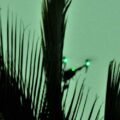The Defense Advanced Research Projects Agency (DARPA) has quietly launched an ambitious new initiative to develop technologies to detect and observe underwater human-made neutrinos, or “ghost particles.”
Dubbed the Experimental Neutrino Detector program, DARPA has not revealed how it intends to use a novel subsurface neutrino detection system in line with the Department of Defense’s (DoD) usual secrecy regarding underwater naval technologies.
However, solicitation documents obtained and reviewed by The Debrief show the program will be focused on detecting accelerator-sourced neutrinos. These types of neutrinos are human-generated using a particle accelerator to collide an accelerated beam of protons against a fixed target.
This suggests that DARPA may be exploring using neutrinos for long-range underwater communication or detecting clandestine nuclear activities, including tracking enemy nuclear submarines.
“The Experimental Neutrino Detector program seeks to conduct experiments observing accelerator-sourced neutrinos in natural bodies of water [and] aims to conduct experiments exploring the trade-spaces in a neutrino detection schema,” a DARPA solicitation notice reads.
Neutrinos are nearly massless fundamental subatomic particles that only interact through the weak force. Sometimes called “ghost particles,” they represent the most abundant particles with mass in the universe, and are produced naturally by sources like the sun and cosmic rays or artificially by nuclear reactors or particle accelerators.
Neutrinos are notoriously difficult to detect because they rarely interact with matter, passing through most materials, including the Earth, without leaving a trace. However, neutrinos’ unique properties make them a subject of intense interest for scientific research and potential military applications.
Neutrino detection typically requires large volumes of matter to capture the faint signals produced when neutrinos interact with atomic nuclei. Traditional methods include using water Cherenkov detectors, where neutrinos interacting with water molecules produce charged particles that emit Cherenkov radiation. This radiation, in the form of ultraviolet light, is then detected by photomultiplier tubes (PMTs), enabling scientists to observe neutrino events.
However, Cherenkov detectors are massive and often located deep underground to shield them from cosmic rays and other background radiation.
DARPA’s Experimental Neutrino Detector program seeks to overcome the conventional challenges of neutrino detection by developing more discreet systems that can leverage natural bodies of water as detection sites.
According to DARPA documents, the program will focus on developing and deploying complete detection systems capable of capturing accelerator-sourced neutrino interactions in smaller, shallower bodies of water. These locations could include littoral combat zones near coastlines, inland lakes, or rivers.
While DARPA has not explicitly outlined the military applications driving the Experimental Neutrino Detector program, several potential uses can be inferred.
Neutrinos’ ability to pass through matter makes them excellent candidates for long-range communication systems in challenging environments, including improving submarine communications.
Traditional underwater communication methods, such as sonar, are limited by range and interference. On the other hand, Neutrinos can travel vast distances through water with minimal attenuation, offering a revolutionary approach to secure, long-distance communication for naval operations.
In a 2022 paper published in Bioinformation, University of South Florida professor of bioinformatics Dr. Paul Shapshak said further understanding of astrobiology and innovations in physics are still needed. However, neutrino-based communications could be our best method for interacting with extraterrestrial intelligence (ETI).
“Because of the possible scarcity of life in any single galaxy, to enhance the possibility of life detection, inter-galactic transit neutrinos necessitate consideration,” Dr. Shapshak wrote. “Neutrino-based potential communications are inferred as the optimal mechanism or venue for detection of communications from ETI as well as sending communications to ETI.”
In 2012, physicists performed the first-ever transmission of information using neutrinos, demonstrating that neutrino communication is indeed possible.
Deploying accelerator-sourced neutrino detectors in the world’s oceans could also enhance the U.S.’s underwater surveillance capabilities by providing a better way to monitor nuclear-powered submarines.
Nuclear submarines are powered by onboarded nuclear reactors, including all of America’s current fleet and potential near-peer adversaries like China’s Jin-Class (Type 094) or Russia’s Yasen class vessels.
The splitting of uranium and plutonium atoms in a submarine’s reactor produces heat, generating high-pressure steam. This steam drives propulsion turbines, powering the nuclear submarine. This incredibly efficient process can enable a nuclear submarine to operate and stay submerged for nearly twenty years without refueling.
Efficiency aside, the fragments of atoms split inside a nuclear reactor become unstable and release neutrinos as they decay. These near-massless neutrinos then pass through the submarine and surrounding water unabated.
By deploying accelerator-sourced neutrino detectors in strategic locations, the U.S. military could effectively track enemy nuclear submarines through the unique neutrino signatures produced by their reactors.
Tracking subsurface neutrino emissions could significantly enhance the reconnaissance of nuclear-powered unmanned underwater vehicles (UUVs). Since UUVs do not have a human crew, they can remain submerged indefinitely, making them extremely difficult to detect.
This same principle applies to anything involving nuclear reactions, meaning accelerator-sourced neutrino detectors could be used to monitor other nuclear activities, including surveillance or detection of hidden nuclear facilities or nuclear weapons testing.
Ultimately, a sufficiently advanced neutrino detector, like what DARPA aims to develop, could provide the U.S. with ubiquitous nuclear surveillance and reconnaissance capabilities worldwide and in space.
DARPA’s decision to focus on water-based neutrino detection in smaller bodies of water is strategic.
Large-scale neutrino detectors, such as those deployed in the Antarctic ice (IceCube) or the Mediterranean Sea (KM3NeT), require substantial infrastructure and deep-water environments. DARPA aims to develop more versatile and deployable detection systems by targeting shallower waters.
Shallow water detection presents unique challenges, including higher background noise from cosmic rays and other sources. However, it also offers practical advantages, such as easier deployment and maintenance and the ability to test and iterate on smaller-scale systems before scaling up.
The Experimental Neutrino Detector program will proceed in several phases, beginning with developing and testing prototype detection units. These units will be designed to capture and measure neutrino interactions using an array of PMTs arranged in Digital Optical Modules (DOMs).
The NuMI beam from the Fermi National Accelerator Laboratory (FNAL) will serve as the neutrino source for the experiments. The NuMI beam, which primarily produces muon neutrinos, will provide a controlled environment to test the detection systems. The goal is to distinguish neutrino signals from background noise, ensuring detectors can reliably operate in real-world conditions.
The Experimental Neutrino Detector program will also be “executed on an aggressive timeline,” with initial prototypes expected to be tested and refined within 18 months. DARPA says this expedited development is necessary because the NuMI beam is planned to be decommissioned in June 2026.
The program is anticipated to award a $12 million contract, and industry partners interested in working with DARPA on prototype systems are required to submit initial proposals by July 8.
The Experimental Neutrino Detector program represents a bold step into the future of neutrino research and its potential for military applications.
If DARPA can successfully harness the unique properties of neutrinos and leverage natural water bodies as detection sites, this initiative could pave the way for new, disruptive communication and surveillance technologies.
Tim McMillan is a retired law enforcement executive, investigative reporter and co-founder of The Debrief. His writing typically focuses on defense, national security, the Intelligence Community and topics related to psychology. You can follow Tim on Twitter: @LtTimMcMillan. Tim can be reached by email: tim@thedebrief.org or through encrypted email: LtTimMcMillan@protonmail.com

